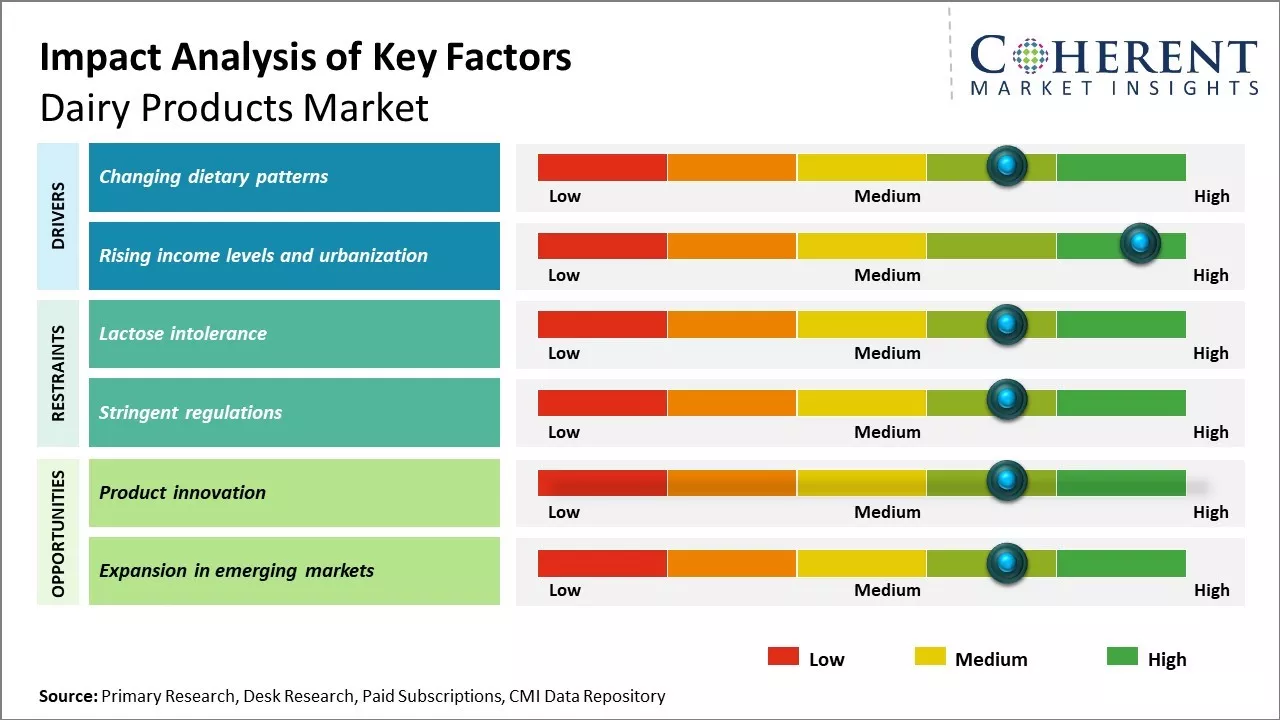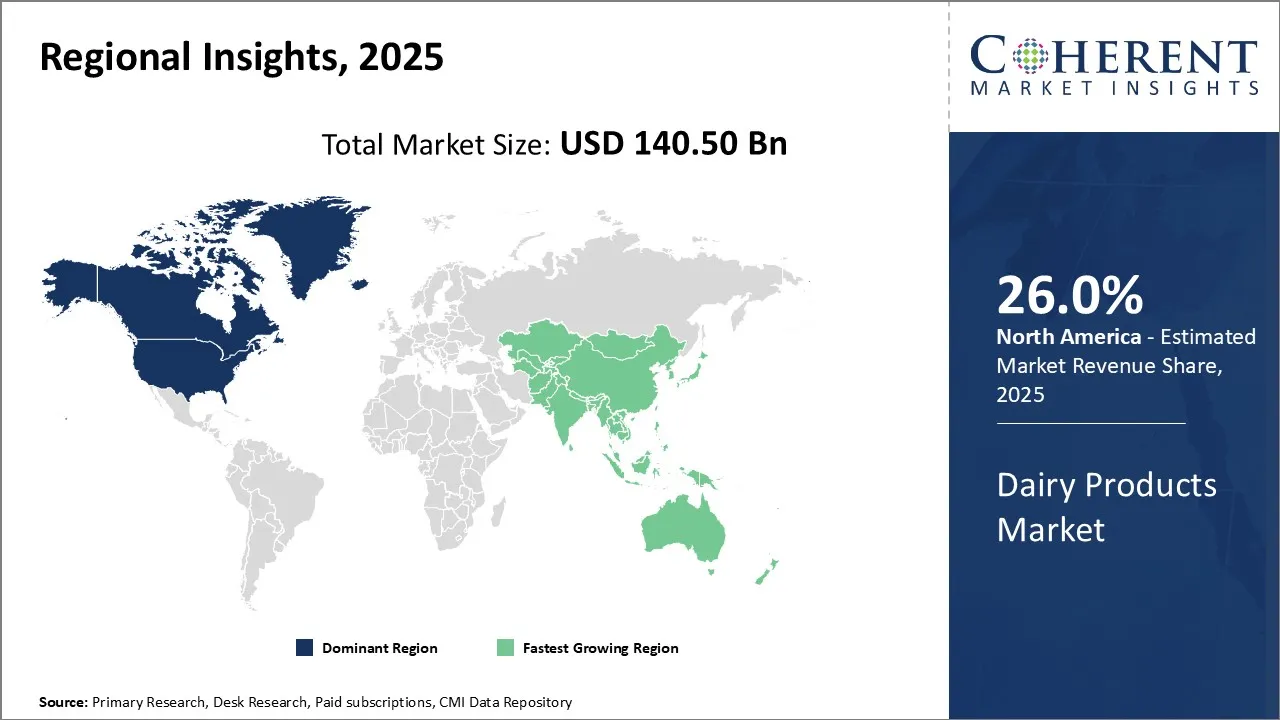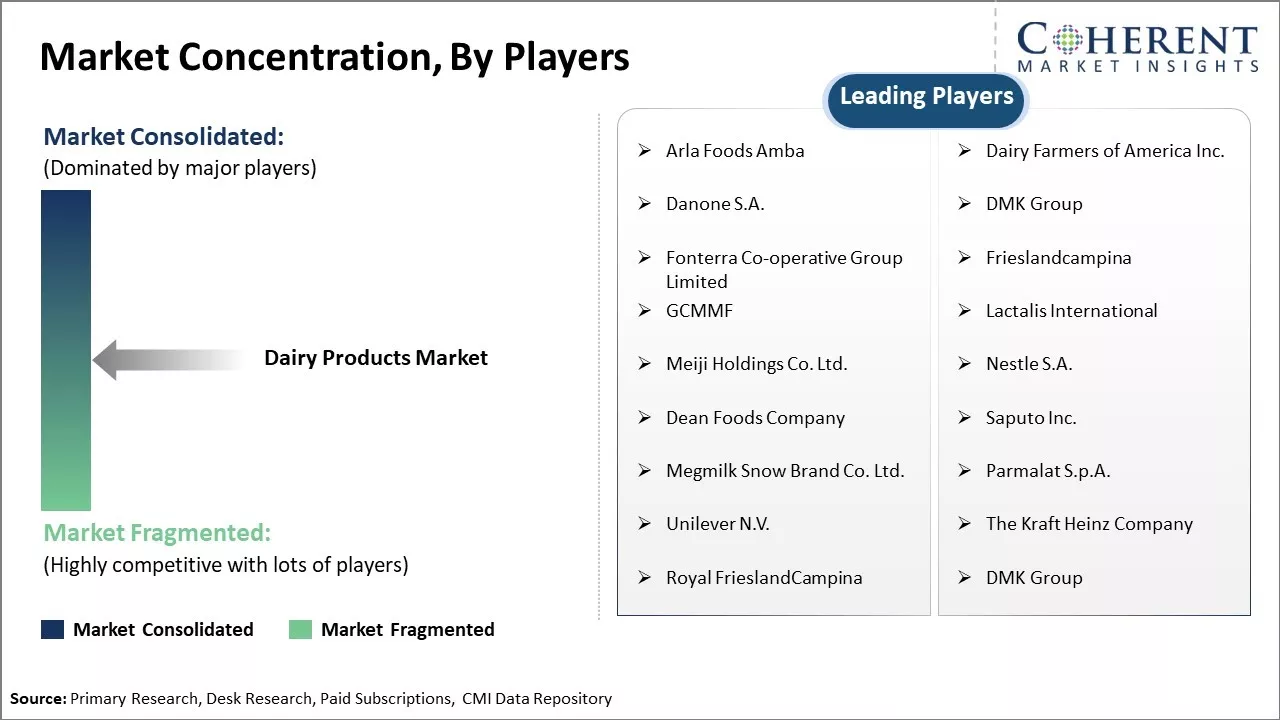The Dairy Products Market is estimated to be valued at USD 140.50 Bn in 2025 and is expected to reach USD 247.26 Bn by 2032, exhibiting a compound annual growth rate (CAGR) of 8.4% from 2025 to 2032.

To learn more about this report, Download Free Sample
Factors such as rising health consciousness, changing consumer preferences, and growing demand for nutritious dairy-based products will drive the market. Increasing awareness about the health benefits of dairy products along with growing affordability is propelling the sales of value-added dairy products such as flavored milk, yogurt, cheese, butter, and cream globally. Rising living standards coupled with growing population will also augment the demand for dairy products. Manufacturers are launching innovative products to cater to dynamic consumer tastes, adopting advanced processing technologies, and leveraging e-commerce channels to boost market presence which will further aid in the market expansion.
|
Current Event |
Description and its Impact |
|
Plant-Based Alternative Market Expansion |
|
|
Rising Input Costs and Inflation Pressures |
|
Uncover macros and micros vetted on 75+ parameters: Get instant access to report
|
Country/Region |
Role |
Volume (Metric Tons) |
Value (USD Million) |
Key Products |
Trend |
|
India |
Exporter |
63,738.47 |
272.64 |
Milk, ghee, paneer |
↑ Growing |
|
New Zealand |
Exporter |
~2,000,000+ |
~8,000+ |
Whole milk powder, butter |
↑ Stable |
|
European Union |
Exporter |
~1,500,000+ |
~6,500+ |
Cheese, skim milk powder |
↑ Moderate |
|
United States |
Exporter |
~1,200,000+ |
~5,000+ |
Cheese, whey, lactose |
↑ Expanding |
|
Australia |
Exporter |
~900,000+ |
~3,800+ |
Milk, cheese |
↑ Rebounding |
|
China |
Importer |
~2,500,000+ |
~10,000+ |
Milk powder, cheese, butter |
↓ Slight |
|
Southeast Asia |
Importer |
~1,800,000+ |
~7,200+ |
UHT milk, yogurt, cheese |
↑ Rapid |
|
Middle East & Africa |
Importer |
~1,200,000+ |
~4,500+ |
Long-life milk, ice cream |
↑ Expanding |
Uncover macros and micros vetted on 75+ parameters: Get instant access to report
In terms of product type, the milk segment is expected to hold 31.9% share in 2025, driven by its widespread consumption and nutritional value. As a staple in cooking and a rich source of calcium and protein, it appeals to all age groups. Its affordability, availability across retail channels, and role in promoting health and satiety make it a preferred choice. Educational campaigns and innovations like flavored and lactose-free variants have broadened its appeal. Enhanced farming techniques ensure steady supply, while strong demand persists across urban and rural areas. Milk’s versatility and functional benefits solidify its dominance in both household and institutional consumption.
For instance, in November 2025, Remilk and Gad Dairies launched “The New Milk,” a dairy product made without cows, combining tradition with cutting-edge fermentation technology. This breakthrough offers identical taste and nutrition to conventional milk, while being animal-free and environmentally sustainable. The launch marks a milestone in the future of dairy production.
In terms of distribution channel, the supermarket/hypermarket segment is projected to account for 33.8% share in 2025, driven by their convenience and variety. These large-format stores offer extensive selections of milk, yogurt, cheese, and other perishables, allowing shoppers to fulfill all needs in one stop. Centralized logistics ensure consistent supply, while bulk purchasing enables competitive pricing. Loyalty programs and promotions enhance value, making supermarkets attractive for frequent staples and new product discovery. The “big basket” approach appeals to busy families seeking efficient shopping. Expansion into new neighborhoods further boosts reach, solidifying supermarkets as the leading channel for dairy purchases.
For instance, in November 2025, Israel introduced lab-grown milk to supermarket shelves and cafes, marking a major shift in dairy innovation. Developed using precision fermentation, this cow-free milk mimics traditional dairy in taste and nutrition. The launch reflects growing demand for sustainable, animal-free alternatives in the food industry.

To learn more about this report, Download Free Sample
North America has established itself as the dominant region with 26% share in 20205 in the global dairy products market. With the presence of major players like Dairy Farmers of America, Dean Foods, Leprino Foods, and Schreiber Foods. Supported by advanced infrastructure for transportation and cold storage, dairy producers in the U.S. supply both domestic and international markets efficiently. Being located near large consumer bases, North American companies also have logistical advantages over competitors. Moreover, dairy is a strategic sector for the Canadian and Mexican economies. The Free Trade Agreement has further strengthened dairy trade links between the three NAFTA nations.
For instance, in September 2025, Hain Celestial launched two new dairy products in the United States, reinforcing its commitment to natural and organic offerings. The move aligns with growing consumer demand for clean-label and health-conscious options. This expansion reflects the company’s strategy to innovate within the dairy category and strengthen its market presence.
The Asia Pacific region has emerged as the fastest growing region. Rapid urbanization, rising living standards, and changing dietary habits are fueling strong demand growth in the major Asian countries. China is leading this momentum, where consumption of dairy products has doubled in recent years. Efforts by the Chinese government to boost domestic milk production have seen limited success. As local supply struggles to match booming demand, Asia Pacific nations are increasingly looking outside to fulfill their dairy needs through imports. India is another key opportunity, with dairy being central to both agriculture and nutrition in the country. However, infrastructure bottlenecks and environmental concerns continue to hamper the sector's full potential in Asia.
For instance, in June 2025, Norwegian Red Cow Fresh Milk has launched in China, Asia’s largest premium dairy market. Produced from Norwegian Red crossbred cows, the milk is a result of a partnership between Norway’s Geno and China’s New Hope Dairy. The initiative highlights sustainable farming and high-quality genetics in global dairy innovation.
In 2025, U.S. dairy demand is rising due to increased milk production, herd expansion, and strong global exports. Competitive prices for butter and cheese, along with evolving consumer preferences for protein-rich and functional dairy products, are fueling growth. The U.S. also benefits from robust international demand, especially in Asia and Latin America.
For instance, in October 2025, Barebells launched its first ready-to-drink protein beverage in the United States, marking a major expansion of its dairy-based product line. The high-protein milkshake caters to growing consumer demand for nutritious, functional drinks and reflects the brand’s commitment to innovation in the health-focused dairy segment.
In 2025, China’s dairy demand is surging due to rising incomes, urbanization, and growing health awareness. Consumers are shifting toward high-quality, protein-rich foods, including milk, yogurt, and cheese. Government support for domestic dairy production and increased interest in imported premium products is also fueling market growth across urban and emerging regions.
For instance, in July 2025, Junlebao Dairy expanded its Extended Shelf Life (ESL) milk production capacity in southern China to meet rising consumer demand for fresh, high-quality dairy. The move strengthens its supply chain and reinforces its commitment to innovation and sustainability in China’s rapidly growing dairy market.
| Report Coverage | Details | ||
|---|---|---|---|
| Base Year: | 2024 | Market Size in 2025: | USD 140.50 Bn |
| Historical Data for: | 2020 To 2024 | Forecast Period: | 2025 To 2032 |
| Forecast Period 2025 to 2032 CAGR: | 8.4% | 2032 Value Projection: | USD 247.26 Bn |
| Geographies covered: |
|
||
| Segments covered: |
|
||
| Companies covered: |
Arla Foods Amba, Dairy Farmers of America Inc., Danone S.A., DMK Group, Fonterra Co-operative Group Limited, Frieslandcampina, GCMMF, Lactalis International, Meiji Holdings Co. Ltd., Nestle S.A., Dean Foods Company, Saputo Inc., Megmilk Snow Brand Co. Ltd., Parmalat S.p.A., Unilever N.V., The Kraft Heinz Company, Royal FrieslandCampina, andDMK Group |
||
| Growth Drivers: |
|
||
| Restraints & Challenges: |
|
||
Uncover macros and micros vetted on 75+ parameters: Get instant access to report
One of the key drivers of the global dairy products market has been the steady shift in dietary patterns and food consumption habits across various regions. While dairy consumption has traditionally been a staple in developed Western markets, consumption in developing Asian and Middle-Eastern countries is on the rise due to increasing health awareness, disposable incomes, and hectic urban lifestyles.
There is a growing preference toward packaged dairy products such as flavored milk, yogurt, and dairy-based beverages that provide convenience without compromising on nutrition. As more people lead fast-paced lives working long hours, there is demand for dairy options that can be quickly consumed on-the-go. Living independently away from families also drives young consumers to rely more on processed packaged foods including dairy items that can be easily stored and cooked with. Rising health consciousness has been another important factor influencing dairy consumption globally. Studies proving the various benefits of dairy in maintaining strong bones, muscle development and weight management have encouraged many populations to incorporate milk, cheese and yogurt into their diets. In Asian nations where dairy was not a traditional part of cuisine, such health education campaigns by governments and industry bodies have increased awareness about dairy nutrients. This has benefitted yogurt and probiotic milk producers the most.

To learn more about this report, Download Free Sample
Dairy consumption patterns are also evolving owing to rapid economic development and urbanization in emerging markets. Rising disposable incomes allow populations to spend more on high quality nutritious food items deemed essential for a balanced diet or those perceived as luxuries in the past.
In countries like China, India, Brazil, and across Southeast Asia, cities are swelling as rural migrants seek better job prospects and living standards. Living in towns and metropolitan areas exposes people to new trends, globalization of tastes and widespread availability of supermarkets and modern retail offering packaged consumer goods. Higher salaries mean enhanced spending power to purchase dairy items consumed by urban elite communities, seen as aspirational lifestyle products. Rising middle-classes now form the bedrock of dairy product sales as branded dairy companies target this socio-economic group with premium yet reasonably priced new product lines customized to regional preferences.
Product innovation provides a significant opportunity for growth in the dairy products market forecast. As consumers are continuously looking for new, nutritious and convenient options, dairy companies need to proactively develop innovative products that meet these evolving needs and tastes. Some areas that allow for innovation include organic products, plant-based alternatives, probiotic offerings, and single-serve on-the-go packaging formats. One example of innovation helping spur market expansion is the rise of oat milk-based products.
The dairy products market value is undergoing a structural shift in which traditional strengths, large-scale milk availability and entrenched cooperative models are increasingly tested by margin compression and portfolio disruption. Global milk output has continued to rise, yet international dairy prices have softened, creating sustained pressure on processors. This volatility in commodity nodes such as SMP, WMP, and butter reinforces that profitability now depends less on commodity cycles and more on strategic control of procurement, logistics, and product mix.
Competitive dynamics further intensify as alternative proteins mature. Plant-based milk, after years of rapid expansion, recorded declining retail sales in 2024, signalling a plateau that reduces the threat of immediate displacement while still compelling dairy manufacturers to innovate. Meanwhile, regional leaders such as Amul, with strong procurement integration and daily milk collection exceeding 30 million litres, demonstrate that institutional design remains a decisive differentiator in cost and market reach.
Against this backdrop, premiumisation is emerging as the strongest margin lever. Companies expanding into functional dairy ingredients, speciality cheeses, and fortified nutrition maintain stronger pricing power and insulation from commodity swings. Sustainability is also transitioning from a compliance requirement to a competitive advantage, with processors increasingly evaluated on their investments in emission-reducing on-farm practices and resilient supply ecosystems.
Definition: The dairy products market refers to the business of producing and selling milk-based food items globally. It involves the manufacturing, packaging, and distribution of various types of milk such as whole milk, low-fat milk, skim milk, condensed and evaporated milk, and cream. Additional dairy products in this market include butter, cheese, yogurt, ice cream, lactose-reduced milk and plant-based milk alternatives. The dairy products market caters to grocery retailers, food manufacturers, restaurants, educational institutions, and households worldwide. It aims to provide consumers with high-quality, nutritious dairy-based foods and beverages.
Share
Share
About Author
Sakshi Suryawanshi is a Research Consultant with 6 years of extensive experience in market research and consulting. She is proficient in market estimation, competitive analysis, and patent analysis. Sakshi excels in identifying market trends and evaluating competitive landscapes to provide actionable insights that drive strategic decision-making. Her expertise helps businesses navigate complex market dynamics and achieve their objectives effectively.
Missing comfort of reading report in your local language? Find your preferred language :
Transform your Strategy with Exclusive Trending Reports :
Frequently Asked Questions
Joining thousands of companies around the world committed to making the Excellent Business Solutions.
View All Our Clients